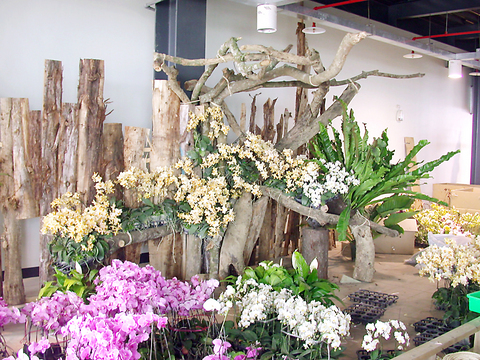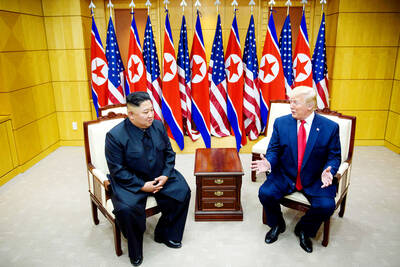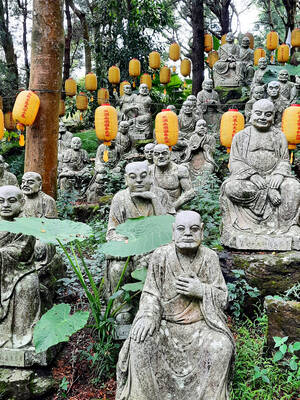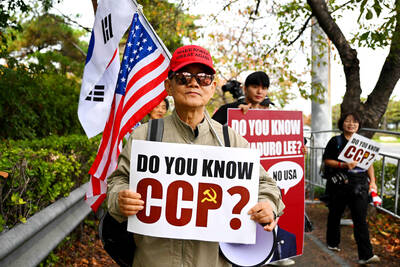Can Taiwan transform itself into an orchid kingdom in the near future? The floriculture community in Taiwan has had this ambitious dream for many years and a positive turn toward such a possibility has just taken place this week.
About two years ago, a plan was launched by the government to build a permanent exhibition site and trading center for local orchid growers. The plan has come to fruition and is about to put to be put to the test, starting from tomorrow.
If it proves successful and the large-scale international orchid exhibition is a success, then Taiwan, the world's leading exporter country of orchids, might be viewed as the natural home of the magnificent

PHOTO COURTESY OF TAIWAN INTERNATIONAL ORCHID SHOW 2005
phalaenopsis.
The government has poured billions of NT dollars into developing the Taiwan Orchid Plantation (TOP) project in Hobi (
The plantation has an area of 200 hectares and is scheduled to be completed in 2008.
Beginning tomorrow, the fourth international orchid show -- the largest annual orchid exhibit in Taiwan -- will be held at the plantation.
With 15 participating countries, this multi-national floral exhibit will showcase more than a thousand orchids to the public, until April 10.
Cosponsored by the Tainan County Government and Council of Agriculture, this 14-day event expects to attract approximately half a million flower lovers from all over Taiwan and abroad.
Three major areas will feature different varieties of orchids, flower arrangements and landscape design. Handicrafts with orchids, the chance to experience the fragrance of the flowers and other attractions will be enjoyed by visitors. There will even be a section devoted to orchid stamps from around the world.
The award-winning Orchid Exhibition Hall (
The Sales Booth Hall (
According to Su Mao-shiang (蘇茂祥), an official from the Agriculture and Food Agency, at the Council of Agriculture, Taiwan is the world's largest exporting country of orchids, with Japan, North America, Europe and Hong Kong as its major markets. The flowers bring in an annual income of around US$60 millions for the country.
Stiff competition is coming but Su says Taiwan maintained a comfortable lead in the global orchid market and captured a 77 percent share last year.
Exhibition notes:
What: Taiwan International Orchid Show 2005
Where: Taiwan Orchid Plantation (台灣蘭花生物科技園區), Hobi (後壁), Tainan County
When: March 26 to April 10
Tickets: NT$150 per person
Telephone: (06) 6840 684

US President Donald Trump may have hoped for an impromptu talk with his old friend Kim Jong-un during a recent trip to Asia, but analysts say the increasingly emboldened North Korean despot had few good reasons to join the photo-op. Trump sent repeated overtures to Kim during his barnstorming tour of Asia, saying he was “100 percent” open to a meeting and even bucking decades of US policy by conceding that North Korea was “sort of a nuclear power.” But Pyongyang kept mum on the invitation, instead firing off missiles and sending its foreign minister to Russia and Belarus, with whom it

When Taiwan was battered by storms this summer, the only crumb of comfort I could take was knowing that some advice I’d drafted several weeks earlier had been correct. Regarding the Southern Cross-Island Highway (南橫公路), a spectacular high-elevation route connecting Taiwan’s southwest with the country’s southeast, I’d written: “The precarious existence of this road cannot be overstated; those hoping to drive or ride all the way across should have a backup plan.” As this article was going to press, the middle section of the highway, between Meishankou (梅山口) in Kaohsiung and Siangyang (向陽) in Taitung County, was still closed to outsiders

Many people noticed the flood of pro-China propaganda across a number of venues in recent weeks that looks like a coordinated assault on US Taiwan policy. It does look like an effort intended to influence the US before the meeting between US President Donald Trump and Chinese dictator Xi Jinping (習近平) over the weekend. Jennifer Kavanagh’s piece in the New York Times in September appears to be the opening strike of the current campaign. She followed up last week in the Lowy Interpreter, blaming the US for causing the PRC to escalate in the Philippines and Taiwan, saying that as

The Chinese Communist Party (CCP) has a dystopian, radical and dangerous conception of itself. Few are aware of this very fundamental difference between how they view power and how the rest of the world does. Even those of us who have lived in China sometimes fall back into the trap of viewing it through the lens of the power relationships common throughout the rest of the world, instead of understanding the CCP as it conceives of itself. Broadly speaking, the concepts of the people, race, culture, civilization, nation, government and religion are separate, though often overlapping and intertwined. A government